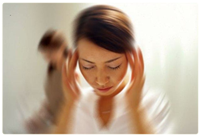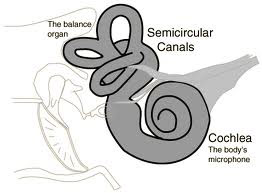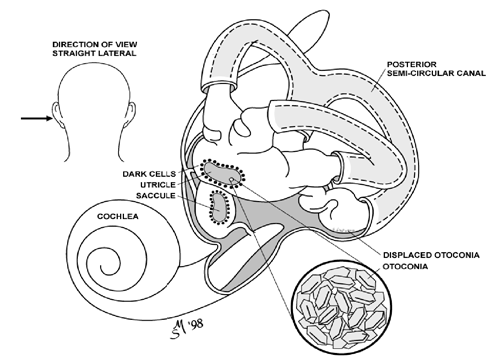Welcome to the Audiology Center at New England ENT and Facial Plastic Surgery
Dizziness and Vertigo

Feeling unsteady or dizzy can be caused by many factors such as poor circulation, inner ear disease, medications, injury, infection, allergies, anxiety, migraine headaches and/or neurological disease. Dizziness is treatable, but it is important for your doctor to help you determine the cause so that the correct treatment is implemented.
What is dizziness?
Dizziness can be described in many ways, such as feeling lightheaded, unsteady, giddy, or feeling a floating sensation. Vertigo is a specific type of dizziness, which is described as an illusion of movement of one’s self or the environment. Some experience dizziness in the form of motion sickness, a nauseating feeling brought on by the motion of riding in an airplane, a roller coaster, or a boat. Others may describe light-headedness, and sensation of feeling faint or unsteady when walking. Dizziness, vertigo, and motion sickness all relate to the sense of balance and equilibrium. Your sense of balance is maintained by a complex interaction of the following parts of the nervous system:

- The inner ear (also called the labyrinth), which monitors the directions of motion, such as turning, rolling, forward-backward, side-to-side, and up-and-down motions.
- The eyes, which monitor where the body is in space (i.e., upside down, right side up, etc.) and also directions of motion.
- The pressure receptors in the joints of the lower extremities and the spine, which tell what part of the body is down and touching the ground.
- The muscle and joint sensory receptors (also called proprioception), which tell what part of the body is moving.
- The central nervous system (the brain and spinal cord), which processes all the information from the four other systems to maintain balance and equilibrium.
The symptoms of motion sickness and dizziness appear when the central nervous system receives conflicting messages from the other four systems.
Evaluation
The physicians at New England ENT are trained in the evaluation and treatment of inner ear disorders causing vertigo. Evaluation involves a detailed history of the patient’s symptoms, general health and related medical problems such as hypertension, heart disease, diabetes, migraine headaches, anxiety and neurological illness, as well as a thorough head and neck and neuro-otologic assessment. We also offer a full line of audiometric studies and electrophysiologic tests to assist in diagnosing the underlying cause of your inner ear problem. Possible additional tests may include a CT or MRI scan of your head, special tests of eye motion after warm or cold water or air is used to stimulate the inner ear (ENG-electronystagmography or VNG-videonystagmography), and in some cases, blood tests, neurology or cardiology evaluation.
Some common inner-ear causes of vertigo include:
- Benign Positional Vertigo: Vertigo is experienced after a change in head position such as lying down, turning in bed, looking up, or stooping. It lasts about 30 seconds and ceases when the head is still. It is a result of dislodged otololiths (crystals) entering one of the semicircular balance canals. It can last for days, weeks, or months. The Epley “repositioning” treatment by is usually curative. BPV is the most common cause of dizziness after (even a mild) head injury.
- Meniere’s disease: An inner ear disorder with attacks of vertigo (lasting hours), nausea, or vomiting, and tinnitus (loud noise) in the ear, which often feels blocked or full. There is usually a decrease in hearing as well.
- Migraine: Some individuals with a prior classical migraine headache history can experience vertigo attacks similar to Meniere’s disease. Usually there is an accompanying headache, but can also occur without the headache.
- Infection: Viruses can attack the inner ear, but usually its nerve connections to the brain, causing acute vertigo (lasting days) without hearing loss (termed vestibular neuronitis). However, a bacterial infection such as mastoiditis that extends into the inner ear can affect both the hearing and equilibrium function of that ear, called labyrinthitis.
- Injury: A skull fracture that damages the inner ear produces a profound and incapacitating vertigo with nausea and hearing loss. The dizziness will last for several weeks and slowly improve as the other (normal) side takes over. BPV may occur after head injury.
- Allergy: Some people experience dizziness and/or vertigo attacks when they are exposed to foods or airborne particles (such as dust, molds, pollens, dander, etc.) to which they are allergic. Recent studies have shown that the inner ear can be involved in the “inflammatory response” to offending allergens.

Treatment
Treatment of dizziness and vertigo depends on the specific cause of your symptoms, but is usually effective. Vertigo resulting from inner ear problems, can be treated by one or more of the following:
- Epley maneuver (canal repositioning maneuver): This is a simple procedure for treatment of BPV (Benign Positional Vertigo) where your head is maneuvered to move the otoliths (crystals) from the semicircular canal to the dependent portion of the inner ear (utricle and saccule). This procedure is usually effective after one or two treatments.
- Medications: Several medications including anti-emetics (anti-nausea medications), anxiolytics (for anxiety), diuretics (reduce body’s retention of fluids), anti-histamines, vestibular suppressants and steroids can be used alone or in combination to manage certain inner ear disorders such as Meniere’s disease and Vestibular neuronitis.
- Balance retraining exercises (Vestibular therapy): These are exercises you learn from a physical therapist to help the central nervous system re-adapt to improve symptoms in certain cases of chronic dizziness.
- Diet and Lifestyle: Staying well hydrated, maintaining a low-sodium diet, avoiding stimulants such as caffeine, managing stress and anxiety may also be recommended for your particular cause of dizziness.
For more information about treatment visit our Physical Therapy Page Here
